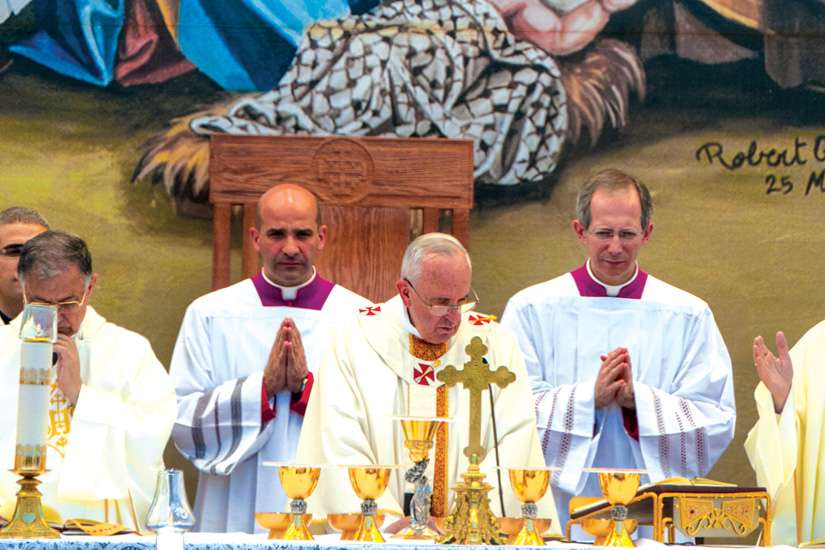The reminder comes in a 10,000-word reflection issued Dec. 10 by the Vatican’s Commission for Religious Relations with the Jews.
“Judaism is not to be considered simply another religion; the Jews are instead our ‘elder brothers’ (St. Pope John Paul II), our ‘fathers in faith’ (Benedict XVI),” it reads.
Though it’s all been said before, Cardinal Kurt Koch and his commission drive home the point that Christians can’t understand our own faith without understanding its Jewish origins.
“One cannot understand Jesus’ teaching or that of His disciples without situating it within the Jewish horizon in the context of the living tradition of Israel; one would understand His teachings even less so if they were seen in opposition to this tradition,” reads the reflection.
Christmastime and the Christmas story are the perfect opportunity for Catholics to learn more about the Jewishness of Catholic faith. The story of the birth of Jesus is rooted in the Old Testament.
When Jewish New Testament scholar Adele Reinhartz starts her lectures about the stories of Jesus’ birth, she often must overcome confusion among her Christian students at the University of Ottawa.
“My students are always shocked when I point out that the story they know as the Christmas story is actually some sort of conflation of Matthew and Luke, and that John and Mark don’t have one,” Reinhartz said.
Writing for a mostly Jewish audience, Matthew knew exactly how Jews would understand the story of liberation he was about to tell. His account “has a lot to do with the Book of Exodus,” said Reinhartz. She says that, in terms of Jewish thinking at the time the Gospel was written, the Book of Exodus was a model for God’s intervention in history.”
Matthew tells the story of how Jesus was born in terms that parallel Israel’s escape from bondage in Egypt. This was the surest way of showing that the coming story of Jesus’ crucifixion and resurrection is the story of the liberation of humanity. The first two chapters of the Gospel of Matthew foreshadow the last two chapters.
Exodus begins with Pharaoh instructing midwives to kill the male children of Jewish women. In Matthew, Herod is the foreign king who instructs his soldiers to kill Jewish children. In Exodus, the prophet who leads Israel to liberation, Moses, escapes the slaughter. In Matthew, the prophet who leads all humanity to liberation escapes the slaughter.
Jesus lives through a kind of exodus in reverse, fleeing Israel for the safety of Egypt — the way Joseph in Genesis found refuge in Egypt and thus saved Israel.
Matthew’s Jewish readers would easily make the connection between Jesus and Moses. Each of them would know Moses’ promise to Israel in Deuteronomy 18:15: “The Lord your God will raise up for you a prophet like me from among your own people; you shall heed such a prophet.”
Making this link between Matthew and Exodus was important in a culture that valued the past because, “as soon as you want to make another claim about divine intervention in history it’s going to be more effective if you can link it up to the prior event,” said Reinhartz.
Exodus also looms in the background of the Gospel of Luke. But there are differences. Where Matthew was writing for Jews, Luke had a gentile, likely Roman, audience in mind.
“For Matthew, (referring to Exodus) is to say to his own community, ‘Hey, we’re still Jews.’ For Luke, it’s to say to the larger c ommu n i t y, ‘He y, we’re actually Jewish,’” said University of St. Michael’s College New Te s t a m e n t scholar John McLaughlin.
In the Roman Empire and particularly in the ancient near East, any claim to be a new religion that lacked a foundation in the past was regarded as dangerous.
The gentile Christians needed the safety of being associated with an ancient tribe of monotheists.
But it was more than that. They genuinely believed themselves to be saved by a Jewish Messiah. They knew Jesus was Jewish.
“When Luke is writing, when Matthew is writing, there is no New Testament,” points out McLaughlin. “When they speak of Scripture they mean the First Testament, they mean the Old Testament. That’s Scripture. The fact they use it so extensively means that they’re making a conscious effort to link the experience of Jesus, and in this instance the Christmas story, to link it to those Jewish roots.”
Where the Jewish roots to Luke’s Christmas story really show is in the poetry. There are three poetic passages from the first two chapters of Luke that have entered the Divine Office, the prayer of the Church, in morning, evening and night prayer. They are generally known by their Latin names — Magnificat, Benedictus and Nunc Dimittis.
Mary’s hymn of liberation prayed by monks, nuns and priests around the world every evening is the best known — the Magnificat. It’s a typically Jewish poem built on parallel lines, where the second line seems to repeat the first.
“It’s a hymn of praise. It’s a hymn of liberation too,” said McLaughlin. “The casting down of rulers, the lifting up of the lowly — this kind of thing. This stuff is taken straight from the Song of Hannah (1 Sam. 2:1-10).”
The same theme of liberation, again quoting from the prophets, comes up in the other two great poems of Luke’s Christmas story. Simeon’s prayer (Luke 2:29-32) on being presented with the infant Jesus in the temple is taken from Isaiah’s servant songs (Isaiah 51:4-6). Zechariah’s prophecy (Luke 1:68-79) talks about Israel overcoming its enemies in terms strongly reminiscent of Psalms 132:17.
“By invoking this, the liberation story, you’ve got (the story) rooted in the First Testament,” said McLaughlin. “They’re saying the same thing — that Jesus comes to set us free.”

